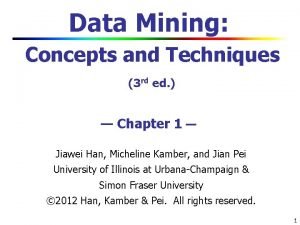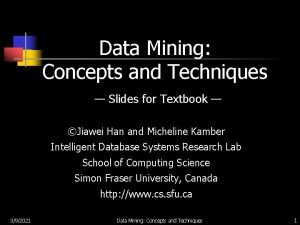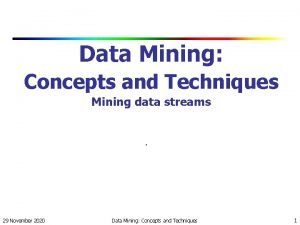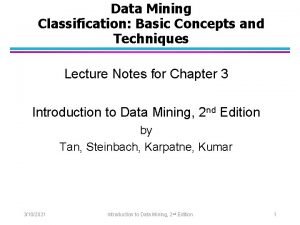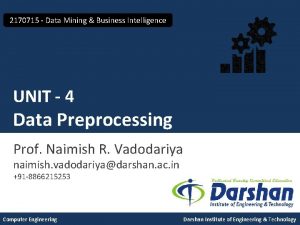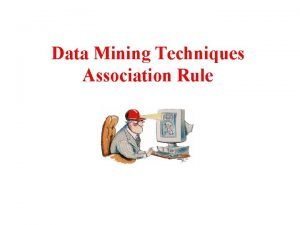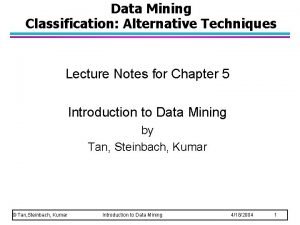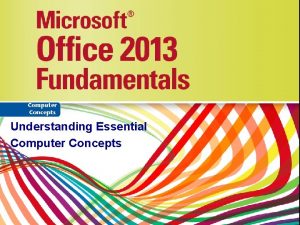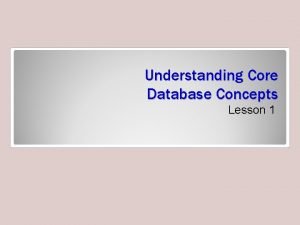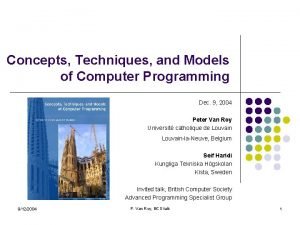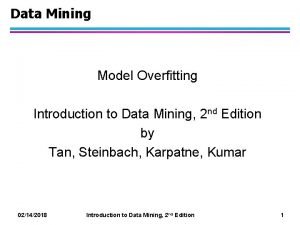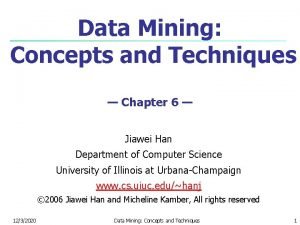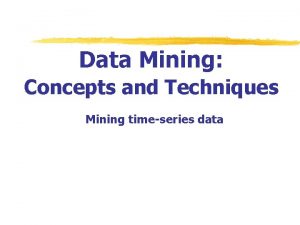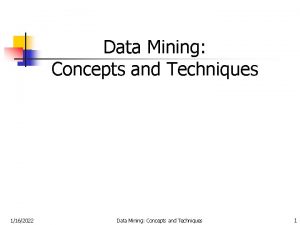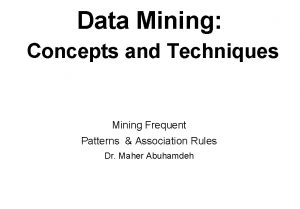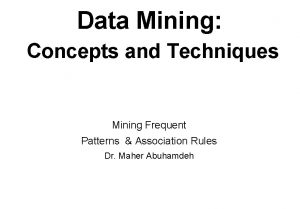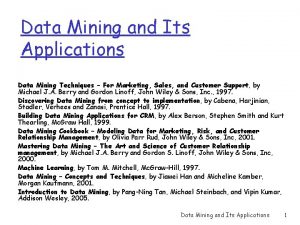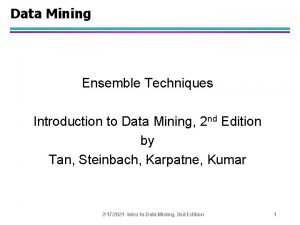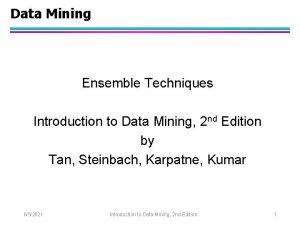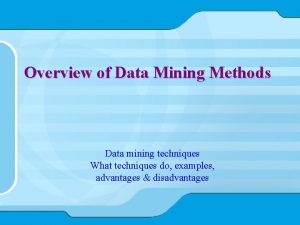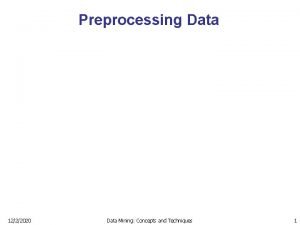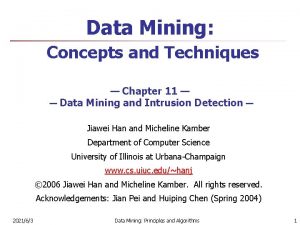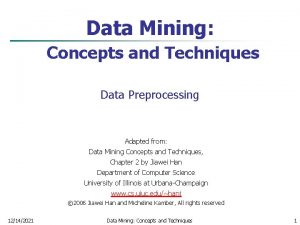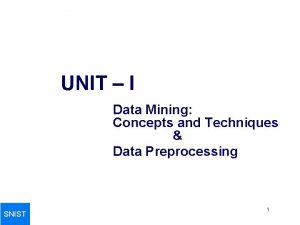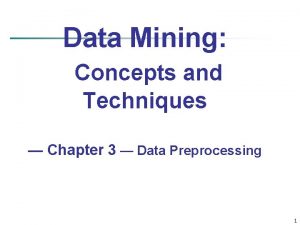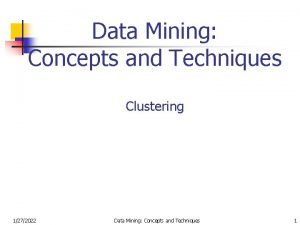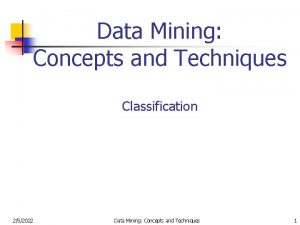Data Mining Concepts and Techniques Data Understanding 1











































- Slides: 43

Data Mining: Concepts and Techniques Data Understanding 1

24 January 2022 Data Mining: Concepts and Techniques 2

Chapter 2: Getting to Know Your Data n Data Objects and Attribute Types n Basic Statistical Descriptions of Data n Measuring Data Similarity and Dissimilarity n Summary 3

Types of Data Sets n n Record n Relational records n Data matrix, e. g. , numerical matrix, crosstabs n Document data: text documents n Transaction data Graph and network n World Wide Web n Social or information networks n Molecular Structures Ordered n Video data: sequence of images n Temporal data: time-series n Sequential Data: transaction sequences n Genetic sequence data Spatial, image and multimedia: n Spatial data: maps n Image data n Video data 4

Important Characteristics of Structured Data n Dimensionality n n Sparsity n n Only presence counts Resolution n n Curse of dimensionality Patterns depend on the scale Distribution n Centrality and dispersion 5

Data Objects n Data sets are made up of data objects. n A data object represents an entity. n Examples: n n sales database: customers, store items, sales n medical database: patients, treatments n university database: students, professors, courses Also called samples , examples, instances, data points, objects, tuples. n Data objects are described by attributes. n Database rows -> data objects; columns ->attributes. 6

Attributes n Attribute (or dimensions, features, variables): a data field, representing a characteristic or a feature of a data object. n n E. g. , customer _ID, name, address Types: n Nominal n Binary n Numeric: quantitative n Interval-scaled n Ratio-scaled 7

Attribute Types n n n Nominal: categories, states, or “names of things” n Hair_color = {auburn, black, blond, brown, grey, red, white} n marital status, occupation, ID numbers, zip codes Binary n Nominal attribute with only 2 states (0 and 1) n Symmetric binary: both outcomes equally important n e. g. , gender n Asymmetric binary: outcomes not equally important. n e. g. , medical test (positive vs. negative) n Convention: assign 1 to most important outcome (e. g. , HIV positive) Ordinal n Values have a meaningful order (ranking) but magnitude between successive values is not known. n Size = {small, medium, large}, grades, army rankings 8

Numeric Attribute Types n n n Quantity (integer or real-valued) Interval n Measured on a scale of equal-sized units n Values have order n E. g. , temperature in C˚or F˚, calendar dates n No true zero-point Ratio n Inherent zero-point n We can speak of values as being an order of magnitude larger than the unit of measurement (10 K˚ is twice as high as 5 K˚). n e. g. , temperature in Kelvin, length, counts, monetary quantities 9

Discrete vs. Continuous Attributes n n Discrete Attribute n Has only a finite or countably infinite set of values n E. g. , zip codes, profession, or the set of words in a collection of documents n Sometimes, represented as integer variables n Note: Binary attributes are a special case of discrete attributes Continuous Attribute n Has real numbers as attribute values n E. g. , temperature, height, or weight n Practically, real values can only be measured and represented using a finite number of digits n Continuous attributes are typically represented as floating-point variables 10

Chapter 2: Getting to Know Your Data n Data Objects and Attribute Types n Basic Statistical Descriptions of Data n Measuring Data Similarity and Dissimilarity n Summary 11

Basic Statistical Descriptions of Data Motivation n To better understand the data: central tendency, variation and spread n Data dispersion characteristics n median, max, min, quantiles, outliers, variance, etc. n Numerical dimensions correspond to sorted intervals n Data dispersion: analyzed with multiple granularities of precision n Boxplot or quantile analysis on sorted intervals n Dispersion analysis on computed measures n Folding measures into numerical dimensions n Boxplot or quantile analysis on the transformed cube n 12

Measuring the Central Tendency n Mean (algebraic measure) (sample vs. population): Note: n is sample size and N is population size. n n Weighted arithmetic mean: n Trimmed mean: chopping extreme values Median: n Middle value if odd number of values, or average of the middle two values otherwise n n Estimated by interpolation (for grouped data): Mode n Value that occurs most frequently in the data n Unimodal, bimodal, trimodal n Empirical formula: 13

Symmetric vs. Skewed Data n Median, mean and mode of symmetric, positively and negatively skewed data positively skewed 24 January 2022 symmetric negatively skewed Data Mining: Concepts and Techniques 14

Measuring the Dispersion of Data n Quartiles, outliers and boxplots n Quartiles: Q 1 (25 th percentile), Q 3 (75 th percentile) n Inter-quartile range: IQR = Q 3 – Q 1 n Five number summary: min, Q 1, median, Q 3, max n Boxplot: ends of the box are the quartiles; median is marked; add whiskers, and plot outliers individually n n Outlier: usually, a value higher/lower than 1. 5 x IQR Variance and standard deviation (sample: s, population: σ) n Variance: (algebraic, scalable computation) n Standard deviation s (or σ) is the square root of variance s 2 (or σ2) 15

Data Measures: Three Categories n Distributive: if the result derived by applying the function to n aggregate values is the same as that derived by applying the function on all the data without partitioning n n Algebraic: if it can be computed by an algebraic function with M arguments (where M is a bounded integer), each of which is obtained by applying a distributive aggregate function n n E. g. , count(), sum(), min(), max() E. g. , avg(), min_N(), standard_deviation() Holistic: if there is no constant bound on the storage size needed to describe a subaggregate. n E. g. , median(), mode(), rank() 16

Boxplot Analysis n Five-number summary of a distribution n n Minimum, Q 1, Median, Q 3, Maximum Boxplot n n n Data is represented with a box The ends of the box are at the first and third quartiles, i. e. , the height of the box is IQR The median is marked by a line within the box Whiskers: two lines outside the box extended to Minimum and Maximum Outliers: points beyond a specified outlier threshold, plotted individually 17

Properties of Normal Distribution Curve n The normal (distribution) curve n From μ–σ to μ+σ: contains about 68% of the measurements (μ: mean, σ: standard deviation) n From μ– 2σ to μ+2σ: contains about 95% of it n From μ– 3σ to μ+3σ: contains about 99. 7% of it 18

Graphic Displays of Basic Statistical Descriptions n Boxplot: graphic display of five-number summary n Histogram: x-axis are values, y-axis repres. frequencies n Scatter plot: each pair of values is a pair of coordinates and plotted as points in the plane 19

Histogram Analysis n n Histogram: Graph display of tabulated frequencies, shown as bars It shows what proportion of cases fall into each of several categories Differs from a bar chart in that it is the area of the bar that denotes the value, not the height as in bar charts, a crucial distinction when the categories are not of uniform width The categories are usually specified as non-overlapping intervals of some variable. The categories (bars) must be adjacent 20

Histograms Often Tell More than Boxplots n The two histograms shown in the left may have the same boxplot representation n n The same values for: min, Q 1, median, Q 3, max But they have rather different data distributions 21

Scatter plot n n Provides a first look at bivariate data to see clusters of points, outliers, etc Each pair of values is treated as a pair of coordinates and plotted as points in the plane 22

Positively and Negatively Correlated Data n The left half fragment is positively correlated n The right half is negative correlated 23

Uncorrelated Data 24

Chapter 2: Getting to Know Your Data n Data Objects and Attribute Types n Basic Statistical Descriptions of Data n Measuring Data Similarity and Dissimilarity n Summary 25

Similarity and Dissimilarity n n n Similarity n Numerical measure of how alike two data objects are n Value is higher when objects are more alike n Often falls in the range [0, 1] Dissimilarity (e. g. , distance) n Numerical measure of how different two data objects are n Lower when objects are more alike n Minimum dissimilarity is often 0 n Upper limit varies Proximity refers to a similarity or dissimilarity 26

Data Matrix and Dissimilarity Matrix n n Data matrix n n data points with p dimensions n Two modes Dissimilarity matrix n n data points, but registers only the distance n A triangular matrix n Single mode 27

Proximity Measure for Nominal Attributes n n Can take 2 or more states, e. g. , red, yellow, blue, green (generalization of a binary attribute) Method 1: Simple matching n n m: # of matches, p: total # of variables Method 2: Use a large number of binary attributes n creating a new binary attribute for each of the M nominal states 28

Proximity Measure for Binary Attributes Object j n A contingency table for binary data Object i n Distance measure for symmetric binary variables: n Distance measure for asymmetric binary variables: n Jaccard coefficient (similarity measure for asymmetric binary variables): n Note: Jaccard coefficient is the same as “coherence”: 29

Dissimilarity between Binary Variables n Example n n n Gender is a symmetric attribute The remaining attributes are asymmetric binary Let the values Y and P be 1, and the value N 0 30

Standardizing Numeric Data n Z-score: n n n X: raw score to be standardized, μ: mean of the population, σ: standard deviation the distance between the raw score and the population mean in units of the standard deviation negative when the raw score is below the mean, “+” when above 31

Example: Data Matrix and Dissimilarity Matrix Data Matrix Dissimilarity Matrix (with Euclidean Distance) 32

Distance on Numeric Data: Minkowski Distance n Minkowski distance: A popular distance measure where i = (xi 1, xi 2, …, xip) and j = (xj 1, xj 2, …, xjp) are two p-dimensional data objects, and h is the order (the distance so defined is also called L-h norm) n n Properties n d(i, j) > 0 if i ≠ j, and d(i, i) = 0 (Positive definiteness) n d(i, j) = d(j, i) (Symmetry) n d(i, j) d(i, k) + d(k, j) (Triangle Inequality) A distance that satisfies these properties is a metric 33

Special Cases of Minkowski Distance n n n h = 1: Manhattan (city block, L 1 norm) distance n E. g. , the Hamming distance: the number of bits that are different between two binary vectors h = 2: (L 2 norm) Euclidean distance h . “supremum” (Lmax norm, L norm) distance. n This is the maximum difference between any component (attribute) of the vectors 34

Example: Minkowski Distance Dissimilarity Matrices Manhattan (L 1) Euclidean (L 2) Supremum 35

Ordinal Variables n An ordinal variable can be discrete or continuous n Order is important, e. g. , rank n Can be treated like interval-scaled n n n replace xif by their rank map the range of each variable onto [0, 1] by replacing i-th object in the f-th variable by compute the dissimilarity using methods for intervalscaled variables 36

Attributes of Mixed Type n n A database may contain all attribute types n Nominal, symmetric binary, asymmetric binary, numeric, ordinal One may use a weighted formula to combine their effects n n n f is binary or nominal: dij(f) = 0 if xif = xjf , or dij(f) = 1 otherwise f is numeric: use the normalized distance f is ordinal n Compute ranks rif and n Treat zif as interval-scaled 37

Cosine Similarity n n A document can be represented by thousands of attributes, each recording the frequency of a particular word (such as keywords) or phrase in the document. Other vector objects: gene features in micro-arrays, … Applications: information retrieval, biologic taxonomy, gene feature mapping, . . . Cosine measure: If d 1 and d 2 are two vectors (e. g. , term-frequency vectors), then cos(d 1, d 2) = (d 1 d 2) /||d 1|| ||d 2|| , where indicates vector dot product, ||d||: the length of vector d 38

Example: Cosine Similarity n n cos(d 1, d 2) = (d 1 d 2) /||d 1|| ||d 2|| , where indicates vector dot product, ||d|: the length of vector d Ex: Find the similarity between documents 1 and 2. d 1 = (5, 0, 3, 0, 2, 0, 0) d 2 = (3, 0, 2, 0, 1, 1, 0, 1) d 1 d 2 = 5*3+0*0+3*2+0*0+2*1+0*1+2*1+0*0+0*1 = 25 ||d 1||= (5*5+0*0+3*3+0*0+2*2+0*0+0*0) 0. 5=(42)0. 5 = 6. 481 ||d 2||=(3*3+0*0+2*2+0*0+1*1+0*0+1*1) 0. 5=(17)0. 5 = 4. 12 cos(d 1, d 2 ) = 0. 94 39

Chapter 2: Getting to Know Your Data n Data Objects and Attribute Types n Basic Statistical Descriptions of Data n Measuring Data Similarity and Dissimilarity n Summary 40

Summary n Data attribute types: nominal, binary, ordinal, interval-scaled, ratioscaled n Many types of data sets, e. g. , numerical, text, graph, Web, image. n Gain insight into the data by: n Basic statistical data description: central tendency, dispersion, graphical displays n Data visualization: map data onto graphical primitives n Measure data similarity n Above steps are the beginning of data preprocessing. n Many methods have been developed but still an active area of research.

References n n n n n W. Cleveland, Visualizing Data, Hobart Press, 1993 T. Dasu and T. Johnson. Exploratory Data Mining and Data Cleaning. John Wiley, 2003 U. Fayyad, G. Grinstein, and A. Wierse. Information Visualization in Data Mining and Knowledge Discovery, Morgan Kaufmann, 2001 L. Kaufman and P. J. Rousseeuw. Finding Groups in Data: an Introduction to Cluster Analysis. John Wiley & Sons, 1990. H. V. Jagadish et al. , Special Issue on Data Reduction Techniques. Bulletin of the Tech. Committee on Data Eng. , 20(4), Dec. 1997 D. A. Keim. Information visualization and visual data mining, IEEE trans. on Visualization and Computer Graphics, 8(1), 2002 D. Pyle. Data Preparation for Data Mining. Morgan Kaufmann, 1999 S. Santini and R. Jain, ” Similarity measures”, IEEE Trans. on Pattern Analysis and Machine Intelligence, 21(9), 1999 E. R. Tufte. The Visual Display of Quantitative Information, 2 nd ed. , Graphics Press, 2001 C. Yu et al. , Visual data mining of multimedia data for social and behavioral studies, Information Visualization, 8(1), 2009

24 January 2022 Data Mining: Concepts and Techniques 43
 Data mining confluence of multiple disciplines
Data mining confluence of multiple disciplines Data mining concepts and techniques
Data mining concepts and techniques Data mining concepts and techniques slides
Data mining concepts and techniques slides Data mining concepts and techniques slides
Data mining concepts and techniques slides Eck
Eck Mining multimedia databases in data mining
Mining multimedia databases in data mining Basic concepts in mining data streams
Basic concepts in mining data streams Basic concepts of classification in data mining
Basic concepts of classification in data mining Difference between strip mining and open pit mining
Difference between strip mining and open pit mining Web text mining
Web text mining Binning method in data mining
Binning method in data mining Association data mining techniques
Association data mining techniques Classification alternative techniques in data mining
Classification alternative techniques in data mining Strip mining vs open pit mining
Strip mining vs open pit mining Strip mining vs open pit mining
Strip mining vs open pit mining Types of printers
Types of printers Core database concepts
Core database concepts Data mining in data warehouse
Data mining in data warehouse Olap data mart
Olap data mart Data warehousing data mining and olap
Data warehousing data mining and olap Introduction to data warehousing and data mining
Introduction to data warehousing and data mining Concepts techniques and models of computer programming
Concepts techniques and models of computer programming Understanding data and ways to systematically collect data
Understanding data and ways to systematically collect data Data reduction in data mining
Data reduction in data mining What is missing data in data mining
What is missing data in data mining Concept hierarchy generation for nominal data
Concept hierarchy generation for nominal data Data reduction in data mining
Data reduction in data mining Data reduction in data mining
Data reduction in data mining Shell cube in data mining
Shell cube in data mining Data reduction in data mining
Data reduction in data mining Perbedaan data warehouse dan data mining
Perbedaan data warehouse dan data mining Perbedaan data warehouse dan data mining
Perbedaan data warehouse dan data mining Mining complex data objects
Mining complex data objects Noisy data in data mining
Noisy data in data mining Rolap in data warehouse
Rolap in data warehouse Markku roiha
Markku roiha Data compression in data mining
Data compression in data mining Data warehouse dan data mining
Data warehouse dan data mining Cs 412 introduction to data mining
Cs 412 introduction to data mining Data and process modeling
Data and process modeling Typical process description tools include
Typical process description tools include Fonctions techniques
Fonctions techniques Underfitting and overfitting in data mining
Underfitting and overfitting in data mining Overfitting and underfitting in data mining
Overfitting and underfitting in data mining

